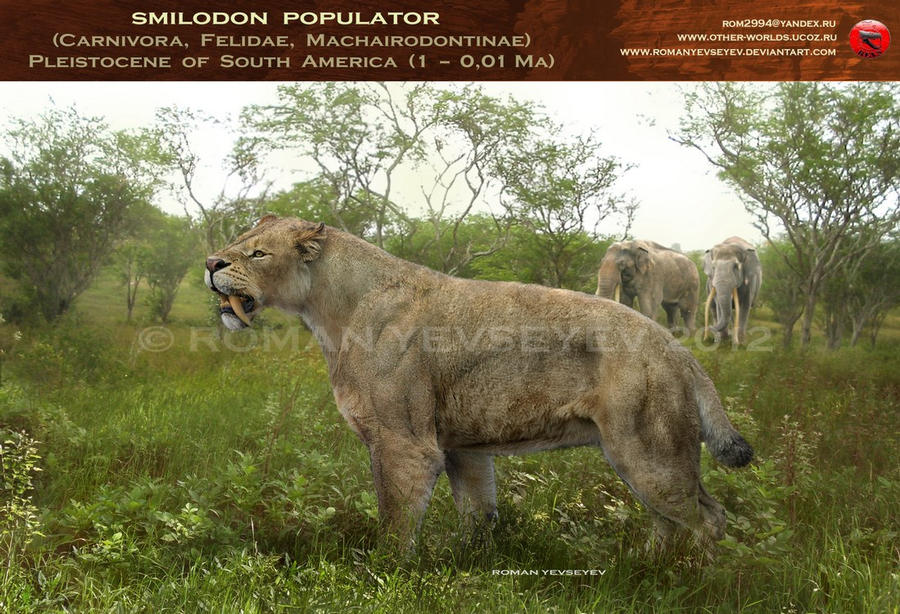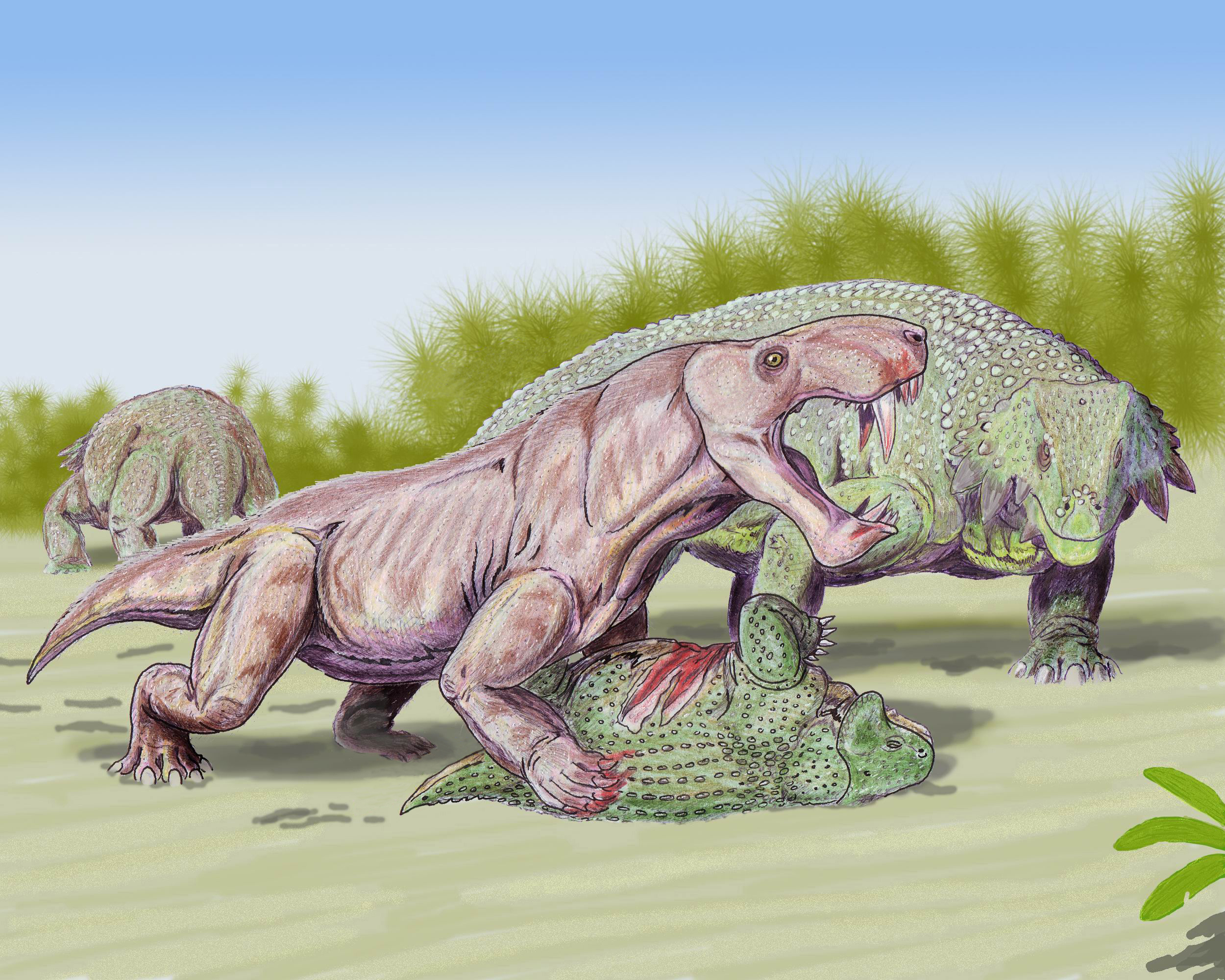Post by Infinity Blade on Apr 10, 2014 6:37:11 GMT 5
Smilodon populator
Smilodon /ˈsmaɪlədɒn/, is an extinct genus of machairodont felid. It is perhaps the best known saber-toothed cat and lived in North America during the Pleistocene epoch (2.5 mya–10,000 years ago). Several fossils have been found with one of the largest collections taken from the La Brea Tar Pits. Three species of the genus are known and they vary in size and build. Overall, Smilodon was more robustly built than any modern cat, with particularly well-developed forelimbs and exceptionally long upper canines. Its jaw had a bigger gape than modern cats and its upper canines were slender and fragile, being adapted for precision killing. These attributes made Smilodon a specialized hunter of large herbivores like bison and camels. Smilodon likely lived in closed habitats like forests and bush which would have provided cover for ambushing prey. Its reliance on large animals may have been the cause of its extinction. Scientists debate over whether Smilodon was a social animal. Comparison of predator responses to distress calls and the prevalence of healed injuries suggest it was social, while its small brain size and vegetated habitat suggest it was more solitary. Some fossils show signs of ankylosing spondylitis, trauma and arthritis. Smilodon went extinct 10,000 years ago. Smilodon populator, 1 million–10,000 years ago; occurred in the eastern parts of South America and was larger than the North American species. It is perhaps the largest known felid, with a body mass range of 220 to 400 kg (490 to 880 lb). It stood at a shoulder height of 120 cm (47 in). Compared to S. fatalis, S. populator had a more elongated and narrow skull, higher positioned nasals, more massive metapodials and slightly longer forelimbs relative to hindlimbs.

Credit goes to Roman Yevseyev
Inostrancevia latifrons
Inostrancevia is an extinct genus of carnivorous therapsids, containing the largest members of the family Gorgonopsidae, predators characterized by long, saber-tooth-like canines. It inhabited Northern Russia during the Upper Tatarian (Vyatskian), a russian regional stage equivalent to the Wuchiapingian stage of the Late Permian period, dating from approximately 260 to 254 mya. It is known from several skulls and two almost complete skeletons. The species in Inostrancevia were the largest gorgonopsids known, known individuals have total body lengths reaching up to 3.5 m (11 ft 6 in) and long, narrow skulls up to 60 cm (24 in) long. Like several other gorgonopsids, Inostrancevia was characterized by strongly developed canine teeth, with those of the upper jaw up to 15 cm (5.9 in) long, the root corresponding to half its length. Their bodies were slender, with rather short legs. Inostrancevia shared its habitat with Scutosaurus which it likely preyed upon. Weight: ~400 kilograms.

Credit goes to DiBgd (Dmitry Bogdanov)
Smilodon /ˈsmaɪlədɒn/, is an extinct genus of machairodont felid. It is perhaps the best known saber-toothed cat and lived in North America during the Pleistocene epoch (2.5 mya–10,000 years ago). Several fossils have been found with one of the largest collections taken from the La Brea Tar Pits. Three species of the genus are known and they vary in size and build. Overall, Smilodon was more robustly built than any modern cat, with particularly well-developed forelimbs and exceptionally long upper canines. Its jaw had a bigger gape than modern cats and its upper canines were slender and fragile, being adapted for precision killing. These attributes made Smilodon a specialized hunter of large herbivores like bison and camels. Smilodon likely lived in closed habitats like forests and bush which would have provided cover for ambushing prey. Its reliance on large animals may have been the cause of its extinction. Scientists debate over whether Smilodon was a social animal. Comparison of predator responses to distress calls and the prevalence of healed injuries suggest it was social, while its small brain size and vegetated habitat suggest it was more solitary. Some fossils show signs of ankylosing spondylitis, trauma and arthritis. Smilodon went extinct 10,000 years ago. Smilodon populator, 1 million–10,000 years ago; occurred in the eastern parts of South America and was larger than the North American species. It is perhaps the largest known felid, with a body mass range of 220 to 400 kg (490 to 880 lb). It stood at a shoulder height of 120 cm (47 in). Compared to S. fatalis, S. populator had a more elongated and narrow skull, higher positioned nasals, more massive metapodials and slightly longer forelimbs relative to hindlimbs.

Credit goes to Roman Yevseyev
Inostrancevia latifrons
Inostrancevia is an extinct genus of carnivorous therapsids, containing the largest members of the family Gorgonopsidae, predators characterized by long, saber-tooth-like canines. It inhabited Northern Russia during the Upper Tatarian (Vyatskian), a russian regional stage equivalent to the Wuchiapingian stage of the Late Permian period, dating from approximately 260 to 254 mya. It is known from several skulls and two almost complete skeletons. The species in Inostrancevia were the largest gorgonopsids known, known individuals have total body lengths reaching up to 3.5 m (11 ft 6 in) and long, narrow skulls up to 60 cm (24 in) long. Like several other gorgonopsids, Inostrancevia was characterized by strongly developed canine teeth, with those of the upper jaw up to 15 cm (5.9 in) long, the root corresponding to half its length. Their bodies were slender, with rather short legs. Inostrancevia shared its habitat with Scutosaurus which it likely preyed upon. Weight: ~400 kilograms.

Credit goes to DiBgd (Dmitry Bogdanov)








